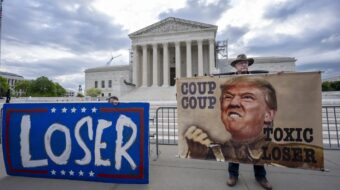
On Wednesday April 26, the Trump administration made good on its threat to set up a system whereby the public can get help in identifying undocumented immigrants who have committed crimes against them. The rollout of the program was announced by Homeland Security Secretary John Kelly, who, without citing evidence, claimed that persons victimized by undocumented criminals have “often” been ignored.
The program consists of a database and a public hotline, both contained within the Immigration and Customs Enforcement (ICE) office of Homeland Security, plus a small counselling staff. Supposedly, victims of crimes committed by immigrants being held in custody by the government can use a part of the new system, the DHS-VINE website, to track the progress of immigrants’ court cases and removal proceedings.
The new entity is called the “Victims of Immigration Crime Engagement,” or VOICE. The new office was immediately bombarded by calls from people complaining about aliens from outer space. It was a humorous response to a ridiculous program, but the government’s action is in fact extremely serious and ominous.
Immediately, there was a strong negative reaction from organizations and activists who are familiar with the immigration issue. The new program is seen as a dangerous attempt to whip up public feeling against mostly minority undocumented immigrants, and to provide “alternative facts” to the strong evidence that immigrants, including undocumented ones, are less likely to commit violent or property crimes than are U.S.-born citizens.
The new office is also intended to counter the tendency of public opinion in the United States to sympathize with the situation of non-criminal undocumented immigrants, and to favor immigration reform that would allow many of them to legalize their situation. In particular, VOICE may be part of the Trump administration’s campaign against “sanctuary cities” which limit their police forces’ cooperation with federal immigration agents.
Salvador Sarmiento, National Campaign Coordinator of the National Day Laborer Organizing Network (NDLON), put his finger on the racist essence of what he calls the “Trump-Sessions agenda.”
“The goal of this program is to instill fear of non-white immigrants,” he said. “It is another deliberate step taken by the Trump administration towards creating institutions that legitimize racist propaganda.”
Others pointed out that the database, as originally released, contains the names of children as young as three-years-old, as well as people in detention while their petitions for political asylum are being processed by the government.
All along, the Trump administration, following the example of the right-wing, anti-immigrant organizations founded by Michigan Ophthalmologist John Tanton, has tried to make the case that immigrants from Latin America, the Caribbean, and the Middle East represent a looming menace to the U.S. public.

The typical stunt has been to selectively highlight specific shocking or gruesome crimes committed or alleged to have been committed by immigrants, and parade the victims or their survivors in public events, such as Trump’s speech to both houses of Congress on March 28. People victimized by persons other than immigrants are not paraded about in this exploitative fashion.
Creating the VOICE office is an escalation of this deceptive tactic. Why deceptive? Consider a few examples of how such an approach has led to serious abuses in the past, or might have.
A while ago, a humorous website, “News of the Weird,” gave us a good example of how this sort of thing can be abused. The site pointed out what seemed to be an extreme tendency for criminals in the United States to bear the middle name Wayne. The list of depraved people with the middle name Wayne that the website put together seems eerily impressive indeed, until one realizes that one could create a much longer list of depraved reprobates who bear the first name John. Or Edward. Or, perhaps, Donald.
But such lists are meaningless and subject to deceptive misuse unless one could somehow prove that the number of people with the middle name Wayne who commit crimes is proportionally greater than the occurrence of this middle name in the overall population.
This kind of mistake, if it is a mistake, has been made by serious criminologists in the past. The most glaring example is the supposed founder of modern criminology, the Italian Cesare Lombroso (1835 -1909). Lombroso, whose racist beliefs were pretty blatant, concluded that there are “criminal types” that can be identified by their physical appearance. Such things as sloping foreheads or extra long arms were seen by Lombroso as “atavistic” and resembling the appearance of apes and “savages.”
To Lombroso, it seemed perfectly logical that a person whose appearance was “savage” would also act like a savage: violent, impulsive, and without the moral constraints supposedly imposed by civilization. Moreover, Lombroso believed that criminal tendencies were inherited.
In his publications, Lombroso provided many photographs and drawings of what he considered criminal types. Looking at them today, one sees portraits not of “criminal types” but of poor people from poor areas of Italy in the late 19th century. They don’t look too happy in the pictures, but that may be because a large proportion of these illustrations are probably police portraits of people under arrest.
In some cases, Lombroso’s criteria for spotting potential criminals are easily refuted by examples of moral paragons who had the same physical “defects.” While Lombroso claimed that facial asymmetry was an indicator of a propensity toward crime, it was also a notable feature of Abraham Lincoln’s visage. Left-handedness was another characteristic stigmatized by Lombroso’s work, an idea which has long been discredited. Yet the association of left-handedness with moral defectiveness led to untold suffering and shame for generations of southpaws and their families.
Lombroso’s theories have been long since refuted by more scientific approaches to criminology. However, they were widely believed at the time. Trump’s effort, I suspect less honest than Lombroso’s, to identify crime with non-white immigrants, is also readily refutable by examination of statistical evidence. But it will have, and in fact is already having, an impact on mass thinking about darker-skinned foreign-born people – as intended.
And that is really criminal.












Comments